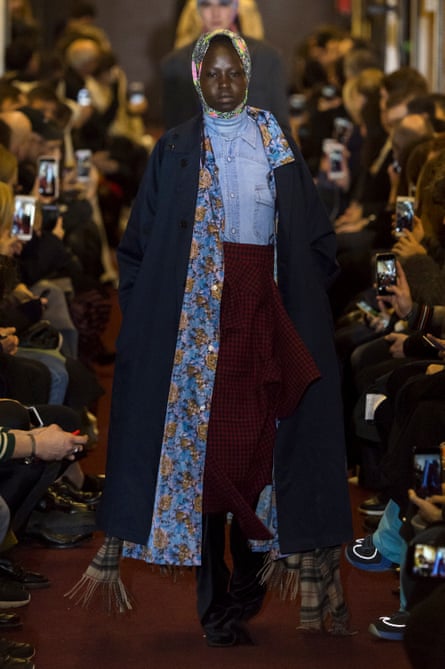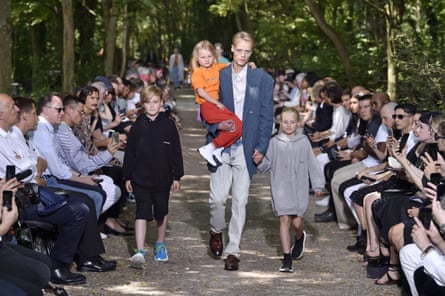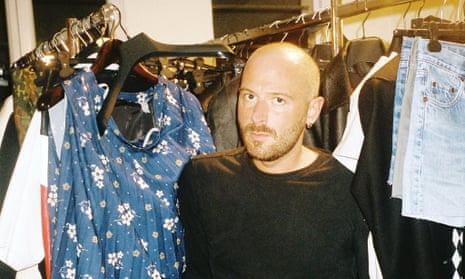To understand what makes Demna Gvasalia the hottest designer in Paris right now, you first need to forget everything you think you know about Paris. Forget Catherine Deneuve, forget Jane Birkin, forget Françoise Hardy. Forget trenchcoats, silk blouses, ballet pumps and straw baskets. Forget Amélie in Montmartre and Carrie Bradshaw in Ladurée.
The Paris of Gvasalia, designer of Vetements and Balenciaga, is not that Paris. Instead, it is the Paris you might recognise if you were gripped by the latest series of gritty French police drama Spiral. It is the city we glimpse through the eyes of Louise, the nanny in Leïla Slimani’s novel Lullaby, when she makes the after-work journey from her employers’ chic 10th arrondissement home to her down-at-heel neighbourhood. It is a city of phone shops and fast food, a city where glamour means tight jeans and fake handbags, a city where background noise is a different language on every street corner, not a harmonious Édith Piaf soundtrack.
A fortnight ago, Gvasalia showed his new Vetements collection there during men’s fashion week, on a makeshift catwalk marked out on the threadbare carpet of Les Puces de Saint-Ouen flea market, models weaving between stalls loaded with gold ornaments, piles of rugs, haphazard ornamental mirrors. As a venue, it was about as far from the tropes of fashion week – lavish hotel ballrooms, expensively neutral all-white marquees – as it is possible to get. The models wore headscarves and raincoats, slogan T-shirts and zip-up fleeces.

“I don’t think elegance is relevant,” says Gvasalia, cheerfully. It is the week after the show and he is holed up in his Paris studio, trying to fend off a cold in the brief lull before buildup to his Balenciaga show on 4 March begins in earnest. “Vetements is about the street, and on the street I don’t think elegance is what people are aiming for.” At most fashion shows, looks are kept fastidiously under plastic until the 11th hour, with backstage dressers helping the models into them at the last moment, to avoid creases or marks. At this show, which Gvasalia styled himself, the models were dressed early and then sat around chatting until the show. As a result, the clothes looked a little lived in. “We do things differently here, I suppose. But, at the same time, it’s the same. Because whether it’s a Vetements hoodie or a couture dress, it’s still about the person putting it on and thinking: ‘I am happy with this, I am happy with how I look.’”
For a man who once told Vogue that “being down to earth is the new black”, Gvasalia’s rise through the ranks is the stuff of fashion fairytales. He burst on to the scene in 2014 with Vetements, his cult design collective, and the following year was a riot of hot-ticket fashion shows in gaudy Chinese restaurants, yellow DHL T-shirts on the catwalk and patchwork Frankenjeans, which for a time were even harder to get hold of than Birkin bags. Vetements became the most influential label in modern fashion. (The trends for trophy hoodies and the vogue for long, loose floral dresses, rather than sundress-sized ones, started here.)

The next year, Gvasalia was named creative director of the eminent house of Balenciaga and his world became as glamorous as it was hip. (Put it like this: Kanye West was already turning up to Gvasalia’s shows; once he got the Balenciaga gig, Kim Kardashian started showing up, too.)
“What is different about my point of view is pragmatism,” says Gvasalia. “The fashion world isn’t the real world and my aesthetic is a kind of hyperrealism. I am not interested in trying to live in some kind of dream. I’d be bored to death.” Last year, he moved the Vetements headquarters from Paris to Zurich, where he and his younger brother and chief collaborator Guram Gvasalia, CEO of the label, live. He is phlegmatically unromantic about his departure from fashion’s most storied city. “I do most of my research on my screen, so I can be anywhere; what does it matter?”
Gvasalia was born in 1981 in Sukhumi, Georgia. The strict Soviet aesthetic of his childhood was obliterated in 1989, with the fall of the iron curtain: suddenly, there was pop music, Coca-Cola, Vogue magazine, a collage of clashing visuals. The most recent Vetements show was “closer than ever to my eastern European background”, Gvasalia says. “It was 100% me, 100% my aesthetic.” The cast included a 16-year-old girl “from the area of Georgia I grew up in – it was a coincidence, we cast her from Instagram, but when I put her in a red jacket and flowery dress, with a headscarf and boots, she looked just like one of the women from the area I grew up”. When Gvasalia was 10, civil war broke out and the brothers fled with their mother and grandmother through the Caucasus mountains. Forced by the terrain to abandon their car, they continued on foot, selling a Kalashnikov to buy a horse for their grandmother, and settled in Georgia’s capital, Tbilisi. It is a startlingly unusual background for a fashion-week darling and one which Gvasalia relates with matter-of-fact pithiness.
“Taking risks is something I got used to as a kid and that is in the DNA of Vetements,” he says. “In fashion now, you need to take risks to survive.” Vetements has shown womenswear during the menswear shows, hoodies during haute couture week, adapting and evolving as the Gvasalia brothers see fit. (“We started the brand from scratch and I cannot adapt a four-year-old brand to industry rules that are a century old.”) Early on, buyers from Barneys in New York who visited the Vetements showroom inquired about the brand’s minimum order, a rule put in place by most houses to protect their bottom line through economies of scale. They were told that there was no minimum order, only a maximum one; Vetements strategy was to ensure that demand would outstrip supply and so build buzz. Eyebrows were raised all over Paris, but the tactic worked.

Right now, Gvasalia has an obsession with honesty. “Look what’s going on in Hollywood,” he says. “Look what’s going on everywhere around us. We need to be transparent.” The recent Vetements show addressed in trademark blunt fashion the issue of Gvasalia’s creative debt to the legacy of Martin Margiela, for whose label he worked for several years. “Researching how Margiela influenced me as a designer meant touching on some delicate questions about influence and appropriation. It seemed important to me to ask those questions,” he says. The collection included a version of Margiela’s famous cleft-toed Tabi boot – itself a version of a 15th-century sock adapted for the Japanese market, where people wanted to wear them with thonged sandals. “I put the Tabi in because I wanted to directly address the issue of appropriation. What is a source, what is an influence, what is a copy? The answers are difficult to define.”
In step with the zeitgeist, Gvasalia is as keen on technology as he is on authenticity. His next project, for Balenciaga, is an experiment in “a new, technological kind of savoir-faire”. Digital fittings are being trialled on the computer screen, with a view to “installing a part of the Balenciaga atelier that is purely digital”. (Balenciaga, which is owned by Kering, has a budget that offers Gvasalia scope for experimentation beyond what is possible at Vetements.) I ask him how he thinks this new technology will change fashion and he laughs. “I don’t know yet. I can’t see the future. But I think pretty much everything is going to change.”

Comments (…)
Sign in or create your Guardian account to join the discussion